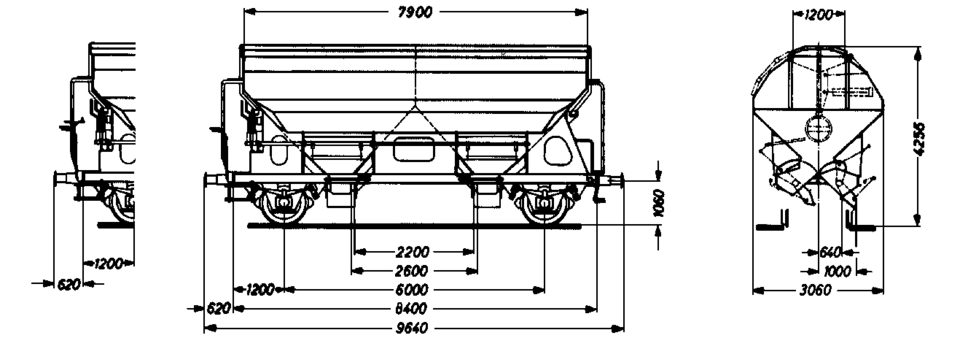Article: Tds 930
Covered bulk freight wagons with controlled gravity unloading and two wheelsets.These wagons are particularly well suited for transporting bulk goods that need to be protected from the weather. They are equipped with a trackside discharge device that allows for controlled unloading of the freight. An interior coating increases the value in use of most of the vehicles, in particular through protection against contamination, options to transport foods, more favourable unloading behaviour (slippage) for goods with poor flow properties and improved corrosion protection for aggressive cargo.
Please note: Type is similar to the wagon in the photo. For exact dimensions, please refer to the drawing and the data below.
Technical details
Loading space (m3) | 38.0 |
Inside width of hopper (mm) | 1,200 |
Inside length of hopper (mm) | 7,900 |
Average tare weight (kg) | 13,000 |
Maximum speed (km/h) | 100 |
International usability | RIV |
Harmonisation/standardisation | UIC St |
Smallest radius of curvature (m) | 35 |
First year of delivery or year of construction of the oldest wagons at this time | 1961 |
Conversion year | 1965–1978 (from Ed 090) |
Parking brake | With and without parking brake |
Brake type | KE-GP |
Number of brake cylinders (pcs.) | 1 |
Brake cylinder diameter (mm) | 300 |
Type of load-proportional braking | Two-stage, mechanical, to be changed over manually |
Buffer type: end force (kN) | 350 |
Buffer type: stroke (mm) | 75 |
Buffer head dimensions (mm) | Avg 370 |
Automatic coupler | Mostly prepared |
Distributor valve type | KE 1adSL or KE 1adSL-D |
Individual data
Type of spring suspension | Double link |
Width of the fixed discharge chutes (mm) | 500 |
Width of the swivelling additional chutes (mm) | 630 |
Running gear as per drawing | Fwg726.02.000.01 |
Load limits
Tare weight > 12.5 t ≤ 13.0 t
With and without parking brake
A | B1 | B2 | C | |
|---|---|---|---|---|
S | 19.0 t | 23.0 t | 23.0 t | 27.0 t |
Additional information:
The wagons are suitable for transporting all kinds of moisture-sensitive bulk goods with a grain size < 0.5 mm. The transport of coarse-grained or angular, heavy goods (e.g. gravel, slag, ballast) is not permitted due to possible damage to the inner coating.The wagons are equipped with a lateral sliding roof. The controllable discharge rate enables unloading onto conveyor belts. The swivelling additional chutes allow the wagon to be used for unloading into underground bunkers located directly next to the track. The larger load volume of these wagons compared to Td wagons of earlier types enables better utilisation of the load limit even for cargo with a low apparent density.The underframe is welded from rolled steel sections; the wagon body is also welded. St 52-3 steel with added copper has been used for the body plates.The side walls are inclined at 43°, the saddle and end walls at 48° to the horizontal.On each long side of the wagon there are two rotary valves, which can be opened and closed individually from the front operating platform. A pawl lock allows the valves to be opened in 25 mm increments up to 200 mm or to be opened fully at 500 mm. The lower edges of the fixed discharge chutes are 720 mm above top of rail when the wagon is empty; the lower edges of the movable discharge chutes are 415 mm above top of rail when swung out and the wagon is empty.To load the wagon, the lateral sliding roof is opened from the operating platform with a hand wheel. This exposes an opening of 1,200 mm width extending over the entire length of the wagon. The open roof remains within the vehicle gauge so that shifting movements are possible even when the lateral sliding roof is open.Cargo residues may only be removed from the loading or unloading lane by lightlyknocking on the outer container walls with a rubber hammer or byusing air blow lances in the loading space!For the operation of the wagons, DV 975/2 must be observed.
